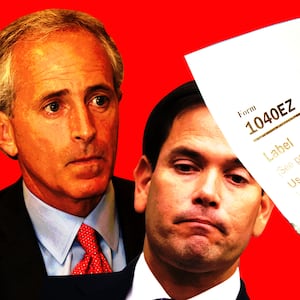Once they got over Alexandria Ocasio-Cortez’s dancing and Instagramming, they really flipped out over her tax talk, which she discussed with Anderson Cooper on “60 Minutes” Sunday night and which CBS leaked out last Friday as a little amuse-bouche to get people to tune in.
Wait, what?! A tax rate of 60 or 70 percent? Is she mad?
Cooper called her idea “radical,” a label she embraced. But in fact there is nothing, nothing, nothing radical about a top 70 percent tax rate. If it’s radical, then Dwight Eisenhower and Richard Nixon were radical, since the top marginal rates when they were president were 91 and 70 percent, respectively (see this pdf), and they made no meaningful effort to lower them.
It’s a totally mainstream position. Democrats owe AOC a favor here for using her unique platform to bring this up, and it’s a position the entire party should embrace with gusto.
A few people like me have already made this case over the weekend: Paul Krugman, Matt Yglesias, and Eric Levitz, notably. I want to join the chorus and give my own spin here, which is partly about how the media present this debate and partly about substance. I’ll start with a basic explanation of what marginal tax rates are, which probably a lot of people and evidently a number of journalists don’t understand.
When people hear that someone wants a tax rate of 70 percent, they probably think that that figure will apply to everyone, on every dollar they earn. This is certainly what Republicans will spend many millions of dollars between now and 2020 trying to get people to think.
Grover Norquist tweeted something to this effect Saturday, suggesting that AOC wants 70 percent of “your production.” It’s a lie, and he’s a smart man, so he knows it’s a lie, but he and the rest of them will keep telling it.
But of course it doesn’t mean that. A high rate like that applies only to rich people. Oh, OK. But still…Is AOC saying that the government should take 60 or 70 cents of every dollar a rich person makes? That still seems punitive.
Yes, it does, but it’s not what she’s proposing. She’s proposing that rate on dollars earned above $10 million.
Here are the 2019 personal income tax rates. A person who makes $11 million pays taxes according to the percentages in this chart as compensation goes up. On her first $9,699, she’ll pay 0 percent, just like everybody else. From $204,101 to $510,300, she’ll pay 35 percent. Then, on every dollar earned above $510,300, she’ll pay the current top rate of 37 percent.
AOC proposes that she would pay 60 or 70 percent not on her entire income, but only on those dollars earned from $10,000,001 and up. Journalism needs to figure out a shorthand way to explain this to people. I italicized “dollars earned above” two paragraphs up because after thinking about this and fighting this fight for years, having to explain this even to some fellow journalists, I believe that’s the best shorthand way to convey it. It’s not a 70 percent rate on “people who make $10 million a year,” as it’s often put, because that implies that that rate would apply to every dollar they make.
AOC, whom the right tries to portray as ditzy, has misspoken on a few matters, but she understands this better than many journalists seem to. She said to Cooper: “That doesn’t mean all $10 million dollars are taxed at an extremely high rate. But it means that as you climb up this ladder, you should be contributing more.”
“Dollars earned above” is the only way to say it, and if the media were to adopt this, it would really help demystify things.
I carry on about this because if everyone understood all this, the battle would be not quite won, maybe, but would be waged on far fairer terrain. Levitz cites polling that shows that people are amenable to a high top marginal rate once they understand it.
Now, to move from media presentation of the topic to the substance of it: Krugman and Yglesias both cite economic research by leading economists arguing that AOC has it right and in fact may even be low-balling it. There is in theory some kind of optimal rate that a) does not disincentivize the rich to produce more work and that b) produces the greatest amount of revenue to pay for the Green New Deal (AOC’s desire) or whatever else.
That’s all true, but the broader point is this. This idea that a 70 percent top rate is “radical” is part of the supply-side snake oil that the right wing has sold this country for 40 years. Lower rates produce greater revenues, they say.
They’re saying it now, because since the 2017 Trump tax cuts, revenue from the personal income tax is up slightly, which can happen sometimes in a strong economy but is not remotely the historic pattern. The Bush tax cuts, for example, cost the treasury around $1.7 trillion (depending on how you measured it). Yet Mitch McConnell and John Boehner and Paul Ryan and nearly every other Republican spent years saying the cuts more than paid for themselves.
But the other truth about the Trump tax cuts, as Jim Tankersley of the New York Times has pointed out, is that they’ve reduced revenue from corporate taxes to a 75-year-low. Hence, the exploding deficit, which the Republicans will inevitably point to when a Democratic president comes in as evidence that those greedy people on food stamps are getting too much, as I explained in this column when the tax cuts passed.
So the broad point here is this: If the Democrats really want to bury supply-side-ism, which I’ve argued is the most important task before them, they have to take dead aim at the core idea of supply-side economics that lower tax rates all the way up the income chain are desirable. It’s a con.
I’ve been banging this drum for years. Here I am in The Guardian in 2010 arguing exactly AOC’s position—a 65 percent rate on dollars earned above $10 million. I’m thrilled that a prominent politician (even if her prominence is out of proportion to her experience) has said it, and the more of them do, the less controversial it will be.







